Identifying Secondary Sources
Stacey Corbitt
Chapter Overview
College success in general, and success in a writing course in particular, depends in large part on disciplined, thoughtful use of sources in research writing. How do you find information about the new, exciting, or even obscure topics that interest you? And why do colleges still have libraries in the age of Google?
Developing information literacy skills includes learning online search techniques as well as de-mystifying the college librarian. Collecting an arsenal of academic research skills affords students the opportunity to learn about a limitless number of subjects through research.
Through study of examples and practice of the information introduced in this chapter, students will learn to identify sources of various types and enlist the expertise of college librarians in academic research. The students’ goal in acquiring these skills is to develop excellent academic research capabilities.
What are secondary sources?
In the past, you may have written a research paper that relied mostly upon studies conducted by researchers who then published their findings in journals, books, or websites. Students typically access these published reports about research others conducted and use those reports as sources of information for their assignments. Those sources, written and often published reports about original research conducted by others, are secondary sources.
Research at the college level may look different to you than previous work you have been assigned. Triangulation of research methods – using a variety of methods to collect and analyze data in an effort to increase validity and reliability within your results – becomes important in college research and beyond. Primary research, involving data you and your colleagues collect through observation, experimentation, and other direct methods, may be a new experience for you. This chapter concerns itself with secondary research as the main resource to be used in early-level college work, and in particular aims to help you learn to identify sources of information that are the result of another’s primary research.
Peer-reviewed journals
The most common, and often most reliable secondary sources for college writers are articles written by researchers. Such articles will often provide clear descriptions of research question(s); research methods; results data; and conclusions. Peer-reviewed journals typically are published by professional associations/organizations and institutes of higher learning. While some peer-reviewed journals are still produced in print form, many are electronic publications that are readily found using library-based search engines (EBSCOhost, for example) to access academic library databases (Academic Search Complete, for example). Begin at the university library web site.
Websites (including blogs)
While their reliability may be questionable (since to some extent they can be published by anyone), websites with the extensions of .com, .org, .edu, and .gov are often used to locate secondary source material. The general categories represented by these suffixes are provided below:
| URL ending | Purpose |
|---|---|
| .com | Commercial website: owned by a for-profit company |
| .org | Website published by a not-for-profit entity generally |
| .edu | Website owned by an educational institution |
| .gov | Website owned by a U.S. governmental entity |
With a classmate, discuss the different types of entities identified in the list above. If you are not familiar with any of these entity types, ask your instructor for examples.
Do you think any of these types of entities produces more reliable, valid, or otherwise superior source material? If so, which one(s) and why? Explain your answer.
Consider the reality that, while a non-profit entity might exist for humanitarian or other presumably noble purposes, the .org designation does not itself guarantee any reliability or absence of bias. Similarly, a .com website can belong to a for-profit company whose research efforts are entirely dedicated to making the world better for everyone. The three-letter extension at the end of a web address provides little or no real information about the motives or integrity of the organization presenting the research.
Blogs, which were originally called weblogs, are sometimes a part of an entity’s website. Other times, blogs are a complete website unto themselves. In either form, blogs are serial online publications that include journal-type entries, called posts, as well as hosted discussion forums. Blogs cover all manner of topic areas and generate revenue through advertising and subscription fees. Blogs are essentially the magazines of the digital realm. As is the case with any website you consider using for secondary source material, writers must carefully evaluate blogs for bias and accuracy.
Like other websites, blogs vary in terms of their validity as secondary sources and therefore must be evaluated carefully before writers rely on them for evidence in support of arguments. Look at the example of a blog found here: https://apastyle.apa.org/blog and respond to the questions below. Be prepared to discuss your responses in class.
- What can you find on the website about the owner, writers, and purpose of this blog? Hint: website designs vary widely, but look for key words and phrases like About Us or Who We Are or Resources sections on a webpage (sometimes, but not always, in a header or footer). In the space provided, quote or paraphrase the information you find in response to the question and include APA-compliant citation(s):
- Next, locate the Search feature for this blog. Frequently, a search function is provided in the header of a web page: in the case of the blog you are reviewing, it is near the top right corner. Use the search phrase conference proceedings and describe what your search produces in the space provided below:
Points for possible in-class discussion:
- What features of this blog make it a potentially useful secondary source?
- Who do you think is the intended audience for this blog? How can you tell?
- Why do you think some posts contain space for comments while other posts do not?
Conference proceedings
Conference is used in this context as a general term that includes meetings, conventions, symposiums, seminars, and other similar gatherings where experts in particular fields of study may present their early research findings, methodologies, and related information for the benefit of peers and students in attendance at the conference. Unlike articles in a journal, the published conference proceedings may include documentation that supplements presentations that were made in person at a conference. Such is the case with the example provided below.
In the previous section’s activity, you learned how to cite conference proceedings as secondary sources. In the activity that follows, an example of a case study that was provided as part of a conference proceedings publication is excerpted for your consideration and response.
Activity: participate in a conference workshop
Review the example of conference proceedings provided below, adapted from the Institute for Global Business Research International Conference Proceedings (2018, pp. 71-75) and discuss with your classmates where indicated. The complete proceedings may be accessed at the following web address: https://www.igbr.org/wp-content/uploads/2018/10/2018-October-Conference-Proceedings.pdf. Note that the three authors listed in the excerpt were probably present at the conference: they may have presented a session at which they demonstrated to conference-goers how to conduct an activity using the “scenes” provided in the case study.
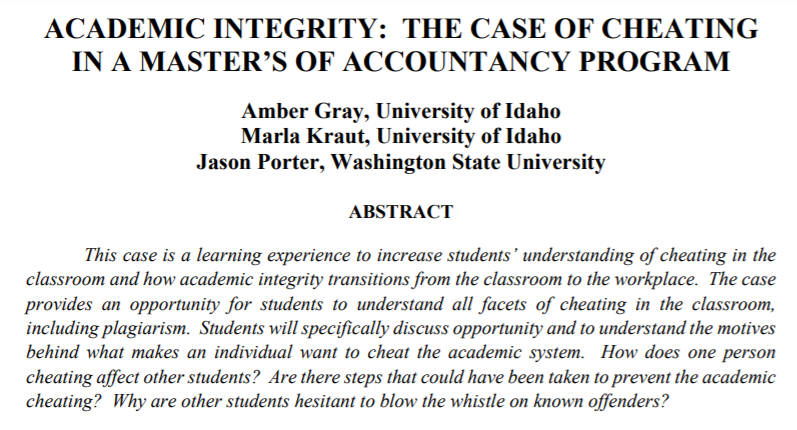
The conference proceedings example continues on the next page with a case summary. Read on and take notes as you need to or as directed by your instructor. You will be responding to one of the various “scenes,” similar to the experience conference attendees may have had.
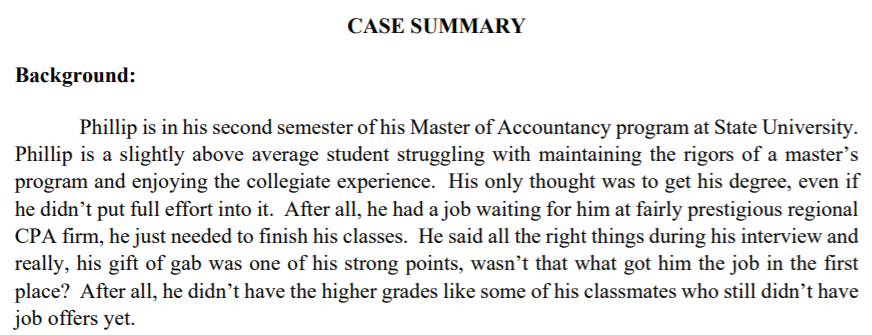
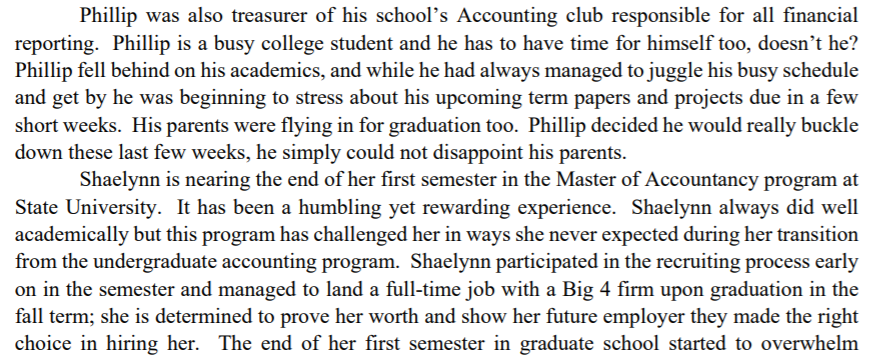
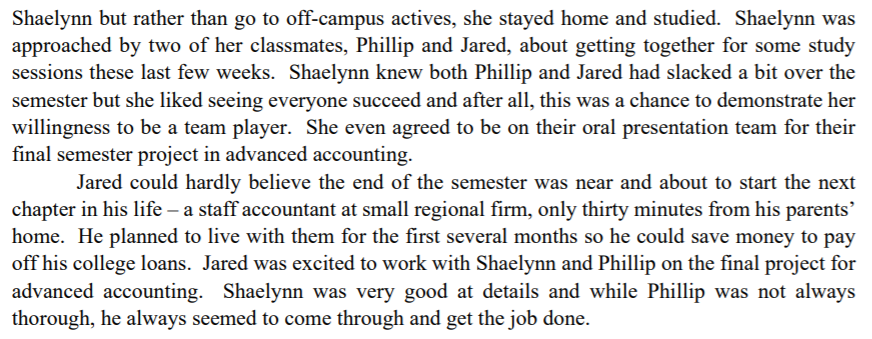
The next excerpt from the example conference proceedings is provided for your review and response. Please review the “scene” (which is one of three that are part of this conference proceedings submission), then respond as directed.



Imagine you were an attendee at the 2018 Institute for Global Business Research International Conference. According to the secondary source (a portion of the conference proceedings) we have been reviewing (IGBR, 2018, p. 71)
Students will specifically discuss opportunity and to understand [sic] the motives behind what makes an individual want to cheat the academic system. How does one person cheating affect other students? Are there steps that could have been taken to prevent the academic cheating? Why are other students hesitant to blow the whistle on known offenders?
Discuss the three questions provided with a partner or as directed by your instructor, and write your responses in the spaces provided below.
- How does one person cheating affect other students?
- Are there steps that could have been taken to prevent the academic cheating?
- Why are other students hesitant to blow the whistle on known offenders?
As noted above, many conference proceedings documents present preliminary research and can be used as secondary sources. Following is an excerpted abstract from another paper (pp. 17-25) presented at the same conference: this time, the author refers to the report as a note, suggesting it is not a complete research report. Nevertheless, the report presents arguments supported by evidence. The report was most likely prepared by the author and submitted to the conference sponsor. The audience for the document, then, is the peers of Yu Peng Lin; and the purpose of the document is to provide supplemental material to the author’s live presentation at the conference.
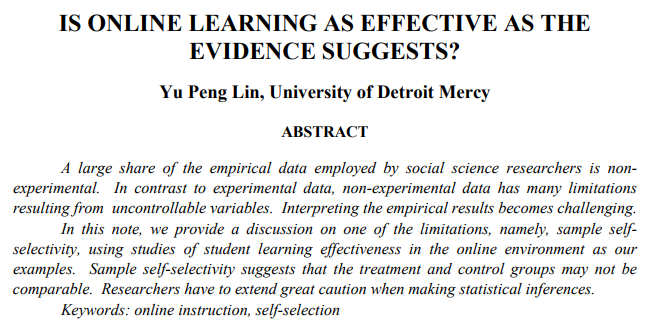
Using this link,,https://www.igbr.org/wp-content/uploads/2018/10/2018-October-Conference-Proceedings.pdf, access Lin’s paper in the conference proceedings and read through it, making notes as needed. At the bottom of page 18 of his paper, Lin concludes that “The majority of empirical evidence supports the position that students generally learn as much online as they do in the traditional classroom environment.” Discuss the arguments and evidence with one or more classmates: does the author agree with the position he says the evidence supports? Be prepared to discuss your response in class.
Books
Although it may have been a long time since you went to a library and checked out a book to use as a source for a research report, books and libraries are still some of the best resources. Whether your research centers around a historical topic or something on the cutting edge of science or technology, don’t forget about these valuable information sources. Books are increasingly available in media other than print on paper. The book you are reading now, for example, was published originally as an electronic document. This book can also be printed and even bound if readers prefer a more traditional reading experience. Additionally, books may be available in a variety of audio formats, making them accessible to even more users than traditional printed books alone. It is quite likely that, if your university library does not own a book you want to review, the library staff can access it through an interlibrary loan.
Using the library
In past writing classes or other courses where you were required to write a research report or another form of major paper, what “rules” about using online sources did you learn?
Compare your answers with your peers and/or compile a master list during class discussion.
Some of the common responses to the prompt above include the following:
- Wikipedia is not an acceptable/reliable source
- Google is not a source (it’s a search engine)
- No sources may be more than X (number of) years old
- Only X (number of) sources may come from online: others must be print documents
While college instructors continue to cringe when asked “Can we use Wikipedia?” acceptable electronic materials are becoming available all the time. It’s not that Wikipedia is necessarily bad: but, according to its own About page: “because anyone can click ‘edit’ at any time and add content, any article may contain undetected misinformation, errors, or vandalism” (https://en.wikipedia.org/wiki/Wikipedia:About, 17 July 2020). So, getting the best results from online sources depends on students’ careful and critical efforts to learn how and where to search for sources.
As electronic resources change and college libraries adapt, more opportunities arise to access useful, reliable, relevant and high-quality source materials using online platforms. Today, some university libraries probably have more students using their resources virtually than have physically walked through the library doors in many years. As college education systems adapt to sudden and sometimes sweeping changes, so are college libraries working to provide all the necessary tools and information in ways students can access them with ease. Be certain that you understand how to access your school’s online library interface as soon as possible, recognizing that access may be different through an internet connection from home than it is from an on-campus computer. Consult the librarians and/or library’s website for specifics.
In a previous section of this chapter, powerhouse online academic search engine EBSCOhost was identified as a place you might look for databases that house electronic versions of peer-reviewed journal articles. This example represents a small selection from a larger sea of academic search tools to which you may have free or low-cost access through your university library. Make an appointment for an in-person or virtual tour of the library and ask the librarian for his or her best recommendations of online search tools. This way, you can be certain you are accessing appropriate peer-reviewed professional publications while avoiding last-minute Google searches that may yield unverifiable results (or worse).
What is the name of the librarian you talked to? What is/are the names of the search engines and database(s) most highly recommended for your assignments by your school library?
College students new to academic research libraries sometimes search the library databases but find they either get too many results that are not useful, or they get no results at all. Talk with the librarian about this phenomenon. What is his or her advice in this instance?
Finally, remember that the main purpose of a campus library is to assist students in learning by providing resources you can use to access information – secondary sources – for use in your research activities. No assignment is too minor, so take the first opportunity you have to get familiar with your campus library, its search engines and databases, and its librarians.
Chapter conclusion
This chapter aims to help students become familiar with – and be able to identify – various types of secondary sources, all of which can be accessed through a college library. Students have been introduced to – or, re-introduced to – their university library and the array of support services it may offer. Being able to identify what source information is needed, as well as to know what sources are once found, allows student writers to research more confidently and to make the best use of library resources through planning and preparation.
Homework
Develop a set of instructions directed toward an audience of new students at your university. The instructions should give the new students the information they need to successfully complete the following tasks:
- Locate and access both the physical library and its website
- Identify the library staff member(s) you recommend first-time students meet
- Arrange a virtual and/or physical tour of the library
- Request interlibrary loans and any other special access you think may be helpful
- Check out physical materials from the library
- Get technical assistance with online library questions
Remember to use illustrations that will help your audience understand and use the instructions.
References
American Psychological Association (2020). APA Style Blog. https://apastyle.apa.org/blog
Gray, A., Kraut, M., and Porter, J. (2018, October 10-12). Academic integrity: the case of cheating in a master’s of accountancy program. In Institute for Global Business Research Conference Proceedings Volume 2, Number 3, pp. 71-75. License: CC-BY-NC-4.0. https://www.igbr.org/wp-content/uploads/2018/10/2018-October-Conference-Proceedings.pdf.
Lin, Yu Peng (2018, October 10-12). Is online learning as effective as the evidence suggests? In Institute for Global Business Research Conference Proceedings Volume 2, Number 3, pp. 17-25.License: CC-BY-NC-4.0. https://www.igbr.org/wp-content/uploads/2018/10/2018-October-Conference-Proceedings.pdf.
